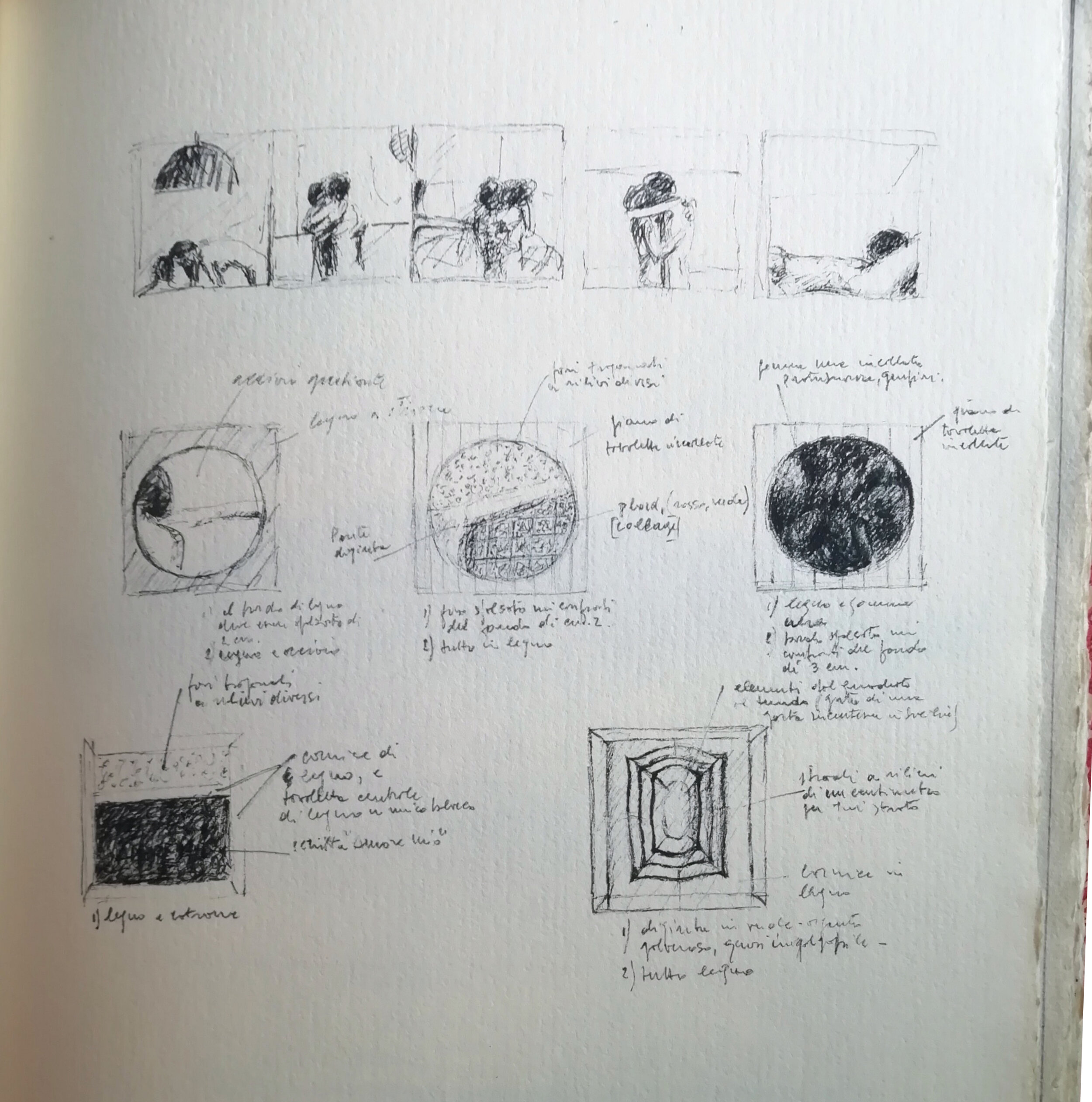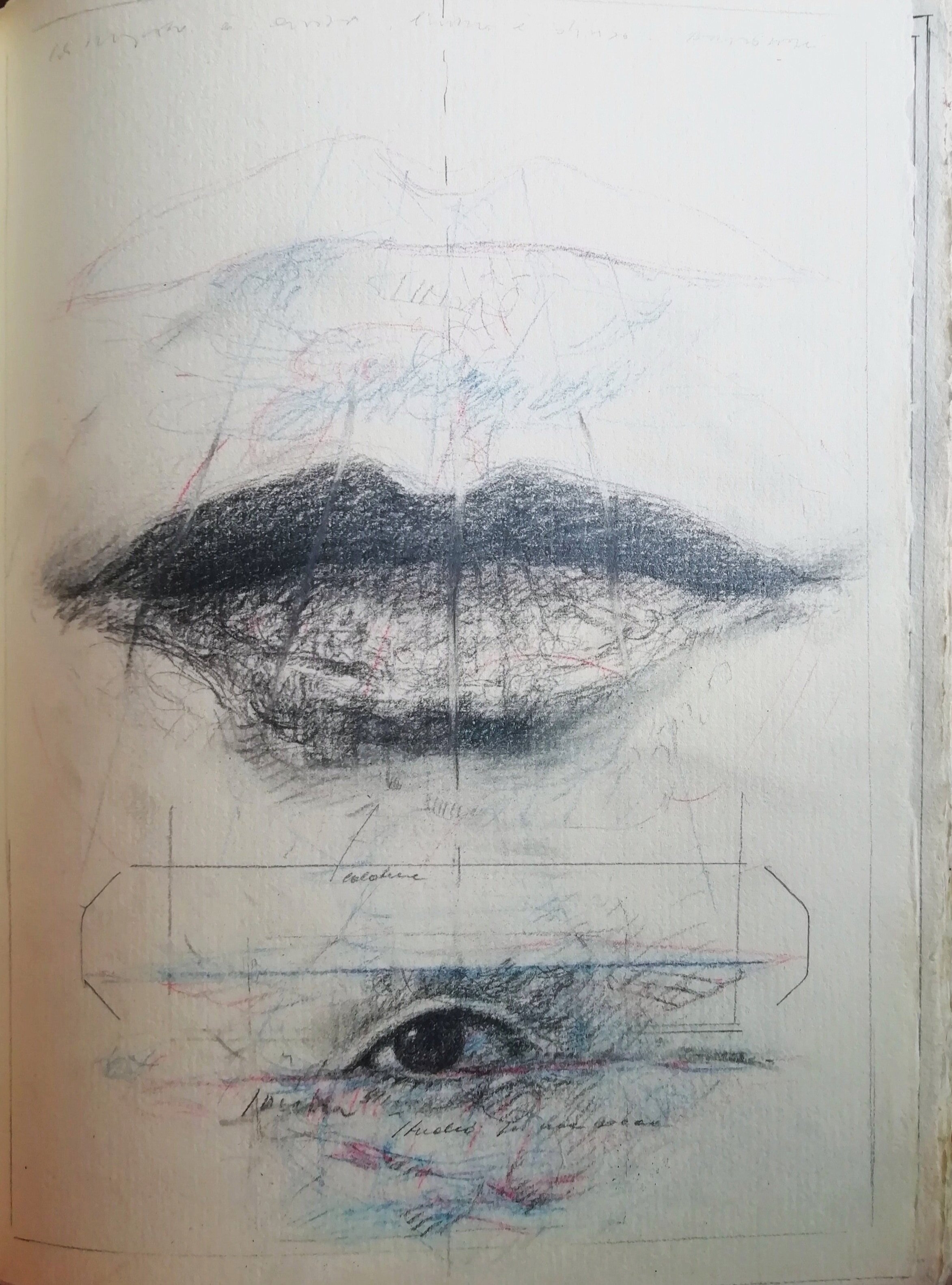An album of drawings by the Scuola Romana
In honour of Master Drawings New York, we are highlighting a handsome album of drawings—dedicated to Rosanna Mataloni, wife of Renzo Vespignani—containing 34 original drawings by 11 artists associated with the second generation of the so-called Scuola Romana (Roman School). A fascinating collection of works by several key artists of the 20th century, the album, bound in half-vellum and covered with decorated paper, documents the tensions and debate between abstraction and realism in the 1960s and 1970s.
The first instantiation of the Scuola Romana (Roman School) centered on the work of Mario Mafai (1902-1965), Scipione (born Gino Bonichi; 1904-1933), and Antonietta Raphaël (1895-1975), and was officially launched in 1928. The group sought to challenge the sort of emptiness they saw pervading Italian art in the 1920s and 1930s, the years dominated by Fascism during the rule of Benito Mussolini (Prime Minister between 1922-1943).
Following World War I, European art witnessed a “return to order” in the revival of classical forms of art. This was particularly strongly felt in Italy as Mussolini actively incorporated art into his Fascist regime (“I do not know,” Il Duce famously proclaimed in 1924, “if one could separate the two names of Italy and Art”). In response to the claims to order, discipline, and objectivity of the neoclassicism that resulted from this return to order, the group of the Scuola Romana espoused the disorder and subjectivity of (German) Expression, which, in their works, was realized through vigorous, even violent facture and moody palettes suggestive of the emotional turbulence of the time. As the 1930s proceeded, however, and various other artists joined the group, the overall aesthetic transitioned into a milder form of expressionism, despite the increasing anti-Fascist sentiment throughout the decade.
Disrupted by the Second World War, a second generation of the School emerged in the 1950s, though the context had altered. This second generation is, in fact, a very loose grouping of artists, united by their interest in investigating new forms of critically engaged figurative art. In the post-war years, tensions arose between abstraction and social realism, the latter—upheld by the School—sought to retain the figure while coming to terms with a new way of representing reality. Vespignani and Renato Guttuso were perhaps the most significant proponents of this latter tendency, as both artists generally placed significant focus on socio-political commentary within their work. Vespignani was particularly invested in representing more run-down environments, attributing a “love for squalid, miserable and dislocated landscapes” to having lived his life in “peripheral area[s] very close to the railways.” One of his two exquisite drawings included in this album (pictured below), dated 1980, demonstrates this theme in his work.
Many of the artists represented here were also involved with Il pro e il contro, formed by Vespignani along with Ugo Attardi, Ennio Calabria, Fernando Farulli, Alberto Gianquinto, and Pierro Guccione, along with the critics Antonio del Guerico, Dario Micacchi, and Duilio Morosini. The group focused on a return to figurative subject matter and to the technique of painting, counter to the rise of Art informel. They also distanced themselves from what they saw as Pop Art’s commodification of iconography. This did not entail a return to earlier modes of representation. Rather, true to the name, Il pro e il contro sought to engage with the pros and cons that characterized contemporary society by juxtaposing new ideas with established tradition.
This perspective can be said to drive all the drawings included in this album, though it represents a range of artists over a broad span of years. To be sure, even such a loose grouping as the Scuola Romana is somewhat problematic in this sense as many of the artists whose works are included in the album established new groups and journals over the years to better suit their own developing artistic projects. There is, however, significant overlap in their activities, and the album is like a fascinating web of history that develops as one moves through the drawings.
In total, the album includes 11 artists—Mino Maccari (1898-1989), Piero Guccione (1935-2018), Sergio Vacchi (1926-2016), Alberto Gianquinto (1929-2003), Franco Gentilini (1909-1981), Ugo Attardi (1923-2006), Sergio Ceccotti (1935-), Gino Guida (1932-2017), Renato Guttuso (1911-1987), Franco Sarnari (b. 1933), and of course Vespignani himself. While a full description of the album will be included in the upcoming Italian Books II catalogue, we offer a preview here of some of the highlights and attractions this enigmatic album has in store.
Renato Guttuso
(1911-1987)
Among the most famous artists included in the album is Renato Guttuso, whom the distinguished art historian Bernard Berenson referred to as “the last painter in the great tradition of Italian art.” Over the course of his long career, he was influenced by a broad range of artists, including Picasso, Caravaggio, and Rosso Fiorentino. At the same time, he remained a committed Communist deeply invested in the project of Social Realism (a very broad term for art that takes contemporary social, political, or economic conditions as its subject matter) and the political potential of art. He thus wrote in 1949, “I believe that art is one of the instruments for the transformation of this unjust and unfair society.” His dual concern with the history of art and contemporary society invested Guttuso’s art with a great range of subject matter. In 1961, for example, he initiated a series of colour drawings that were published in 1970 as Il Dante di Guttuso which included historical figures as characters of Hell. Some of these feature stylistic similarities (albeit with significant thematic differences) with the two works Guttuso contributed to the present album of nude female figures, a theme that was of particular interest to him in the 1960s and 1970s. These sensual treatments of the nude juxtapose the finesse of Guttuso’s pen with a certain nervous charge developed through expressionistic additions of paint in a limited palette. The model for these works is likely the Countess Marta Marzotto, Guttuso’s lover and muse (his actual wife was, however, Mimise Dotti Guttuso) whom he met in 1960.
Franco Gentilini
(1909-1981)
Franco Gentilini is represented in the album by one of his signature stylized cathedrals, a theme that has become practically synonymous with the artist, who first began exploring it in the 1950s. Other themes included landscapes with “irregular perspectives,” cats, and itinerant figures.
Born in Ravenna, Gentilini moved to Rome in 1932 and associated with painters of the Scuola Romana in the late 1930s. This had significant influence on him, as did cubism somewhat earlier and concurrent developments in Paris, where he moved in 1947. His Cathedrals series realize a union of such varied forces as representation is explored along with a fragmenting or breaking down of the image. He returned to Rome in the 1960s where he was a professor at the Accademia delle Belle Arti along with Mino Maccari.
Sergio Ceccotti
(b. 1935)
Born in Rome, Ceccotti attended the Internationale Sommerakademie für Bildende Kunst in Salzburg under the direction of Oskar Kokoschka and drawing courses at the French Academy in Rome from 1956 to 1961. He was greatly influenced by German Expressionism, cubism, and the work of Giorgio de Chirico, although gradually developed a more narrative style in the 1960s as his realm of influence stretched to include film noir and comic strips. The work he contributed to the current album, dated to 1971, highlights such interests as it portrays a nude woman being carried by a King-Kong-type character over an Italianate bridge.
Ugo Attardi
(1923-2006)
Attardi, who was a sculptor and writer as well as a painter, is represented by a fascinating drawing of a female figure that plays with presence and dimensionality through suggestive outlines, multiple layered perspectives, and washes of colour, juxtaposed with the suggestion of a light blue interior frame.
In Rome in 1947, he founded “Forma Uno” along with xxxx. With a drive toward abstraction, the group defined themselves as “formalists and Marxists.” As of the early 1950s, however, with a growing commitment to the Communist party as well as the influence of Francis Bacon and George Grosz, among others, the need for a new relationship with reality began to take hold and his work moved more toward expressionism. Along with Vespignani and other artists, he was involved with the founding of Città Aperta in 1958, and Il pro e il contro in the early 1960s.
Attardi’s bronze sculpture of Ulysses is now in New York’s Battery Park.
Mino Maccari
(1898-1989)
Although an ardent proponent of Fascism in the early part of his career, the writer, journalist, and artist Mino Maccari began to criticize the regime through his journal, Il Selvaggio (“The Wild One”), which he directed from 1926 to 1942. During this time he also enhanced his writings with satirical, often caustic cartoons and illustrations, generally aimed at the bourgeoisie. His pictorial work, which spanned all media, gained prominence over his writing following the Second World War.
The five Works by Maccari included in this album are wonderfully witty examples of his mildly satirical mode, making loving fun of the compilation’s ode-like nature by juxtaposing the artist’s recognizable profile with various beautiful women in surrealist-inspired vignettes.
Franco Sarnari
(b. 1933)
Born in Rome, the self-taught Franco Sarnari is the most well-represented artist in the album, which includes ten of his drawings. These are particularly fascinating as they include drawings of his celebrated triptych Sull-Amore of 1966-67 and document the genesis of his most important cycle, Frammenti, dedicated to the “fragment,” a theme that would dominate his work until the early 1980s. The drawings included here thus demonstrate the extensive, focused, and tireless research that informs Sarnari’s practice while offering fascinating evidence of the theme’s development.
While Sull-Amore included naked, half-length female figures, Sarnari proceeded to further fragment such imagery in Frammenti by playing with close-ups and intimate framing styles that invoke a photographic aesthetic. The results are detailed and often sensual views of bodies that together make up a sort of silent love story. He also produced painted version carried out with a neo-impressionist pointillism technique, a testament to his ongoing conversation with contemporary and historical art and artists.
Much of Sarnari’s artistic development was dedicated to coming to terms with the tension between abstraction and realism. In 1964, he thus founded “Il Girasole” in Rome, a collective of artists with different expressive currents, primarily interested in bridging the divide between the groups of Il pro e il contro and Tartaruga. In 1971, he founded “Il Gruppo di Scicli” along with his good friend Piero Guccione, Sonia Alvarez, Carmelo Candiano, and Franco Polizzi.
How to cite this information
Julia Stimac, "An album of drawings by the Scuola Romana," 29 January 2020, https://www.prphbooks.com/blog/scuola-romana. Accessed [date].This post is licensed under CC BY-SA 4.0.









